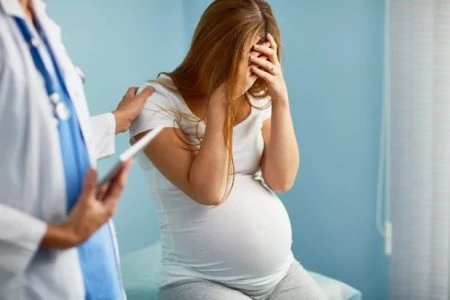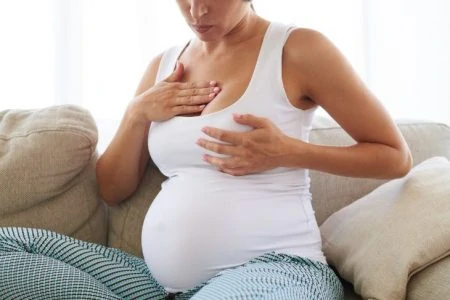Are you having cramps and wondering if it’s a sign of implantation or just your period coming soon?
Implantation cramps are a healthy part of pregnancy and can often be one of the first signs.
In this article, we will discuss what implantation cramps are and how to tell the difference between menstrual and implantation cramps.
We’ll also talk about what you can do for the pain and when you should be concerned.
Key Takeaways
- Implantation cramps are a healthy sign of pregnancy that can happen when a fertilized egg implants in the uterus.
- Implantation cramps are usually mild, intermittent and can last one to three days.
- Implantation cramps can be difficult to distinguish from menstrual cramps, but they may be accompanied by light spotting or implantation bleeding.
- It’s best to take a home pregnancy test one week after a missed period for the most accurate result.
- Tracking your menstrual cycle on a calendar can help you determine if you are experiencing implantation or menstrual cramps.
What Are Implantation Cramps?
For some women, implantation cramps are one of the first signs they have conceived. When conception occurs, the sperm fertilizes an egg in one of the fallopian tubes. Cells start to divide and multiply rapidly within 24 hours.
The fertilized egg remains in the fallopian tube for about three to four days before it slowly moves down the tube to the uterus and becomes a blastocyst.
Once the blastocyst reaches the uterus, it implants in the uterine lining. This process is known as implantation and can often cause what is called implantation cramps. These are usually mild and can be accompanied by implantation bleeding or light spotting (1).
Take Note
How Long Do Implantation Cramps Last?
The blastocyst implants in the wall of your uterus in a short time. This process typically happens anywhere from 8-12 days following ovulation.
Take Note
Menstrual vs. Implantation Cramps
Implantation cramps can happen around the same time as your menstrual cycle, so it can sometimes be difficult to distinguish between PMS cramps and implantation. However, there are a few differences if you pay close attention to your symptoms.
- The intensity of cramps: Notice how heavy your cramps are. Implantation cramps are mild, intermittent, and feel like a pulling or tugging sensation. Menstrual cramps tend to come on gradually and be more intense for most women.
- Duration of cramps: Implantation cramps only last one to three days until implantation is complete. If you’re experiencing pains for longer than three days, they are most likely PMS related.
- Accompanied implanted bleeding: Implantation cramps are often accompanied by implantation bleeding. If you’re spotting and are a bit early for your period, you could be having implantation cramps. Implantation bleeding is also much lighter or even brown in color, whereas PMS bleeding is typically bright red.
Implantation and early pregnancy symptoms occur around the same time, so watch out for additional pregnancy signs usually not associated with PMS, such as:
- Increased urination.
- Dizziness/lightheadedness.
- Nausea and/or vomiting.
- Food and/or smell aversions.
- Metallic taste.
- Missed period.
Likewise, look out for PMS signs not typical of early pregnancy, such as back pain.
If experiencing depression, you should see a healthcare provider to see if you are suffering from clinical depression or a serious, recurrent condition known as Premenstrual Dysphoric Disorder (PMDD).
Editor's Note:
Caitlin Goodwin, MSN, RN, CNMTracking your cycle on a calendar will also give you a better idea if you’re dealing with menstrual cramps or possible implantation cramps.
If you’re still unsure, you can always take a home pregnancy test for a more definitive answer. Some home pregnancy tests claim to be able to detect a pregnancy as early as five to seven days after conception. However, waiting until one week after you would typically have your period will give you the most accurate answer.
Remember that a positive pregnancy test will only happen after implantation occurs because the early developing placenta must be in place in order to produce pregnancy hormones. The test won’t be positive until several days after implantation or the bleeding has occurred.
Editor's Note:
Caitlin Goodwin, MSN, RN, CNMRelief From Implantation Cramps
Implantation cramps can cause some discomfort, but remember, they only last about one to three days. These cramps should be minor enough that you shouldn’t have to take any pain medication. If you do need some relief from implantation cramps, try a few of these techniques:
- Try to relax: Stress only causes even more tension and discomfort, so try to relax. Sit back and prop your feet up to help the pain pass. You could also engage in some relaxation techniques, such as meditation or deep breathing.
- Take a warm bath: A warm bath will also help you relax and ease the tension. The warm water relaxes the ligaments and muscles of the uterus, relieving your cramps.
- Hot compress: As an alternative to a warm bath, place a hot compress on your problem areas.
- Get a massage: Have your partner give you a nice back massage or find a masseuse in your area.
- Stay hydrated: Getting plenty of fluids will go a long way toward easing and preventing cramps.
- Change positions: Simply switching positions may do the trick.
- Yoga: Yoga will put you in a relaxed state of mind, get your blood flowing, and alleviate your pain.
When To Be Concerned
Cramping during early pregnancy is usually normal, but in some cases, it can indicate a serious problem.
Take Note
It may just be gas or your uterus growing, but persistent cramping may also be a sign of a miscarriage, placental abruption, ovarian cyst, urinary tract infection, or ectopic pregnancy.
Take Note
Other Cramps Throughout Pregnancy
Take Note
Your body is going through a lot of changes to accommodate your growing baby. When your uterus starts expanding, the ligaments and muscles supporting it will stretch, and this may result in some cramping. It will likely be more noticeable when you sneeze, cough, or change positions.
During the second trimester, you might begin to notice cramps caused by round ligament pain. The round ligament is a muscle in your lower abdomen which supports your uterus. When this muscle stretches, you may feel a sharp, stabbing pain or a dull ache in your lower abdomen. Round ligament pains will improve with rubbing the area and will worsen with movement.
Other causes of minor cramping during pregnancy include gas and bloating, constipation, and sexual intercourse (4).
Implantation Cramps FAQs
The Lowdown on Implantation Cramping
Implantation cramps are one of the first signs of pregnancy for some women. They can occur anywhere from 8-12 days following ovulation when the fertilized egg implants into the uterine lining.
Implantation cramps are mild and should only last about one to three days. They may also be accompanied by light bleeding or spotting, known as implantation bleeding. The pain shouldn’t be too bothersome, but if you need some relief, try relaxing, taking a warm bath, getting a massage, and staying hydrated.
Cramping during early pregnancy is typically nothing to be concerned about. However, if you’re experiencing severe or persistent cramps or cramps with heavy bleeding, contact your healthcare provider as soon as possible. These are possible signs of an ectopic pregnancy, miscarriage, placental abruption, or an ovarian cyst.











